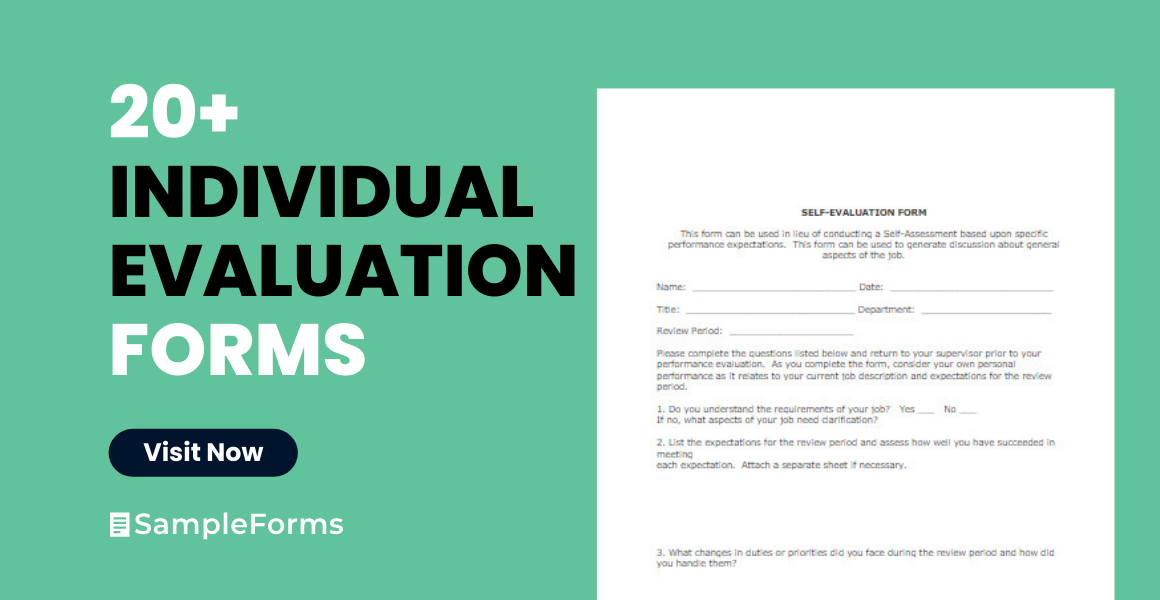An Individual Evaluation Form serves as a critical tool in assessing a person’s performance, capabilities, or qualifications in a systematic manner. Whether in the realm of education, employment, or other personal assessments, these forms provide structured feedback to help individuals grow and organizations thrive. With various types tailored for diverse needs, crafting the perfect form requires precision and understanding. Dive into its meaning, types, exemplary instances, and learn how to create one with useful tips to optimize the evaluation process.
What is an Individual Evaluation Form? – Definition
An Individual Evaluation Form is a structured document used to assess and document an individual’s performance, skills, behavior, or specific qualifications. Typically utilized in educational, professional, or organizational contexts, this form provides a systematic way to capture feedback, observations, and ratings about a person’s abilities or achievements. Its primary purpose is to offer a clear and objective insight into an individual’s capabilities, thereby guiding decisions related to training, promotion, or personal development. These printable form ensures that the assessment is consistent, fair, and based on predetermined criteria.
What is the Meaning of the Individual Evaluation Form?
The meaning of an Individual Evaluation Form extends beyond its mere definition. It symbolizes a systematic approach to understanding a person’s strengths, areas of improvement, achievements, and potential. In essence, it serves as a bridge between the evaluator’s observations and the individual’s self-awareness. When one hears of an Individual Evaluation Form, it implies a process of introspection, feedback, and growth. It’s a recognition of the need to continuously assess, refine, and develop human potential. Such a form is not just about numbers or ratings; it’s a reflection of an individual’s journey, encapsulating their competencies and aspirations.
What is the Best Sample Individual Evaluation Form?
The best sample Individual Evaluation Form is subjective and largely depends on the context in which it’s used. However, I can provide a concise sample that can serve as a generic template suitable for many professional settings:
Employee Details:
- Name: ________________________
- Position: _____________________
- Department: ___________________
- Evaluation Period: From _______ To _______
Performance Assessment (Rate from 1-5, 1 being ‘Poor’ and 5 being ‘Excellent’):
-
Job Knowledge:
- Understands and executes job responsibilities. Rating: _____
-
Quality of Work:
- Consistency and accuracy in tasks. Rating: _____
-
Productivity:
- Completes tasks promptly and manages workload. Rating: _____
-
Communication Skills:
- Conveys and receives information effectively. Rating: _____
-
Team Collaboration:
- Works well in team settings. Rating: _____
-
Problem-solving Abilities:
- Addresses and resolves challenges. Rating: _____
-
Professionalism:
- Maintains a professional demeanor and attitude. Rating: _____
Additional Feedback:
Overall Performance Rating: ______
Evaluator:
- Name: ________________________
- Signature: ___________________ Date: _______
This is a basic form, and it’s crucial to tailor it according to the specific needs and nuances of the organization or context in which it will be used.
FREE 20+ Individual Evaluation Forms in PDF
1. Individual Evaluation Form

2. Individual (Self) Evaluation Form
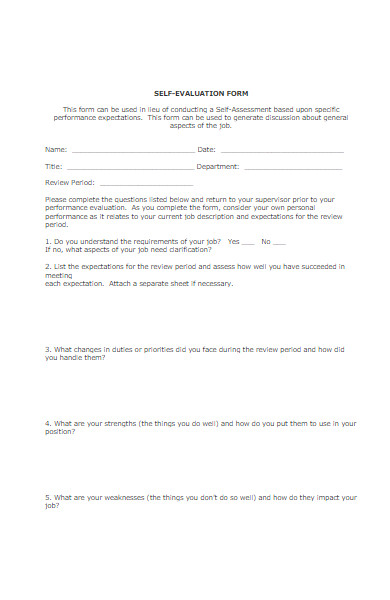
3. Individual Evaluation Request Form
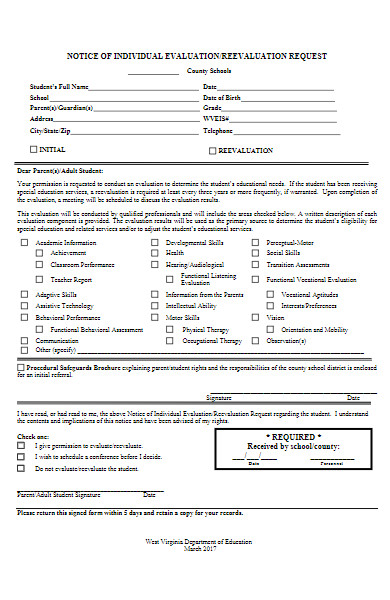
4. Individual Team Evaluation Form
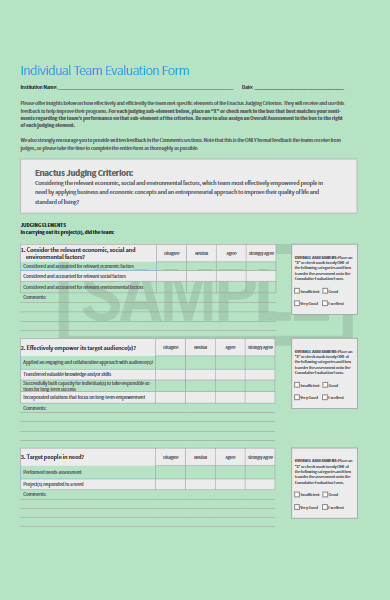
5. Individual Initial Evaluation Form
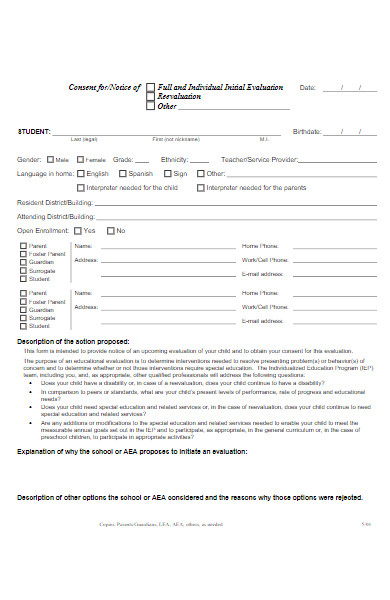
6. Employee Self Evaluation Form
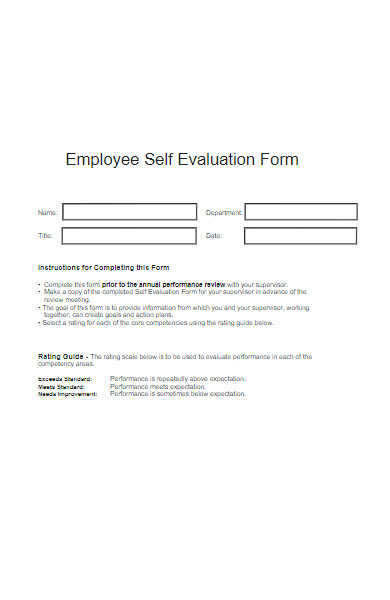
7. Individual Board Member Evaluation Form
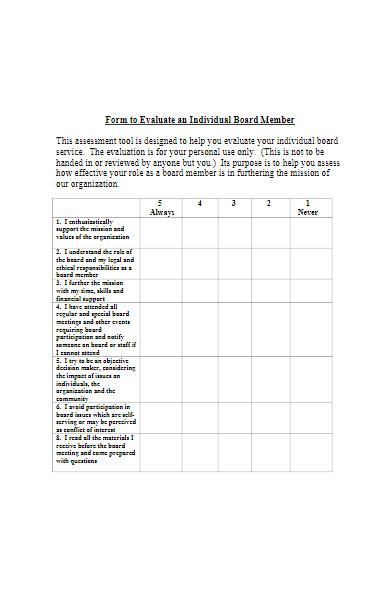
8. Individual Basketball Player Evaluation Form

9. Individual Speech Evaluation Form
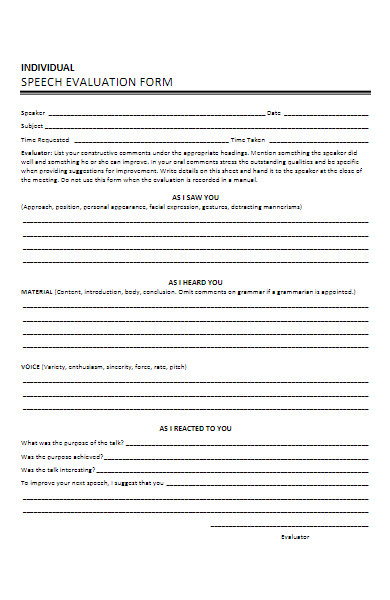
10. University Evaluation Individual Request Form

11. Individual Counseling Evaluation Form
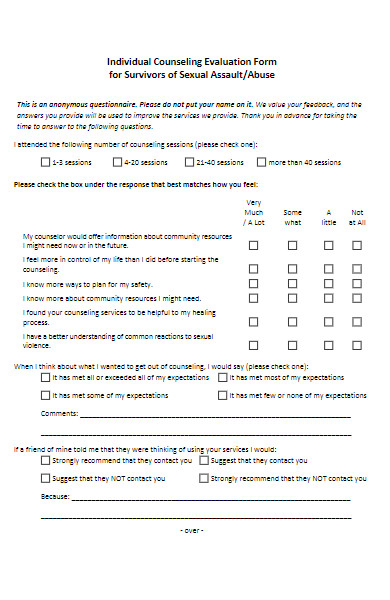
12. Individual Session Evaluation Form

13. Individual Session Evaluation Form Example
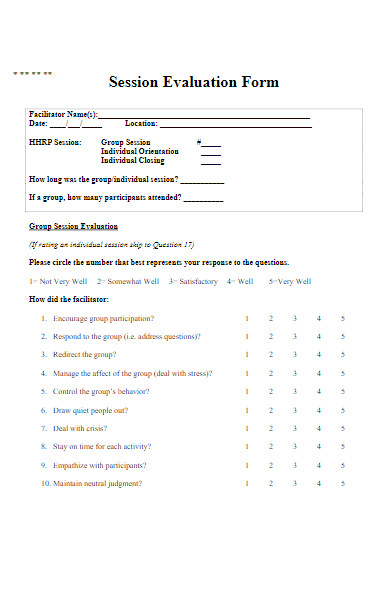
14. Individual’s Performance Evaluation Form
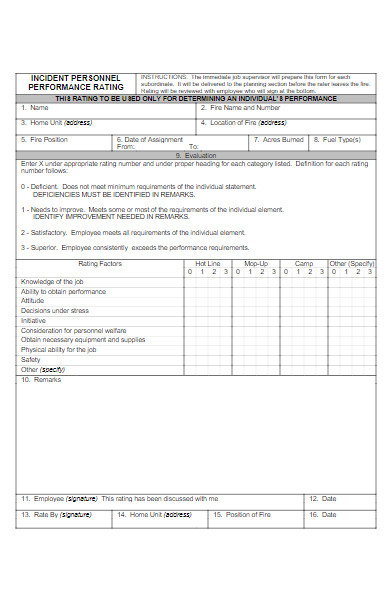
15. Individual Program Evaluation Form
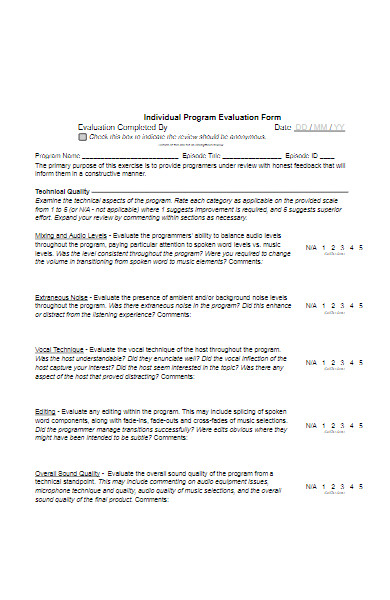
16. Individual or Group Evaluation Form
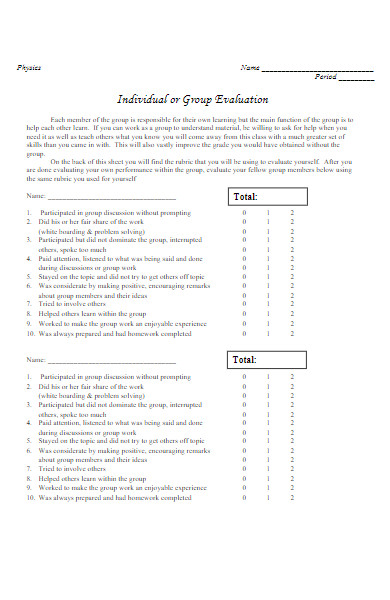
17. Individual Workshop Evaluation Form

18. Individual Presentation Evaluation Form
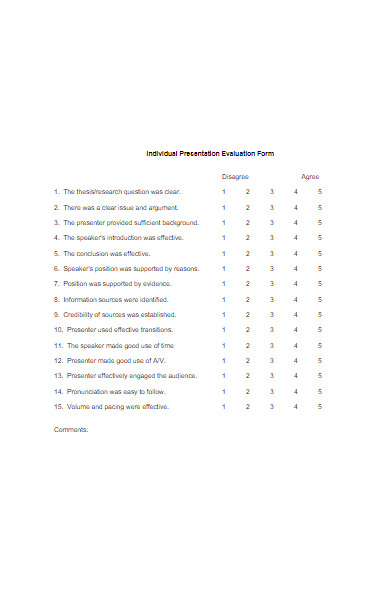
19. Board Member Individual Evaluation Form

20. Individual Team Evaluation Form in PDF
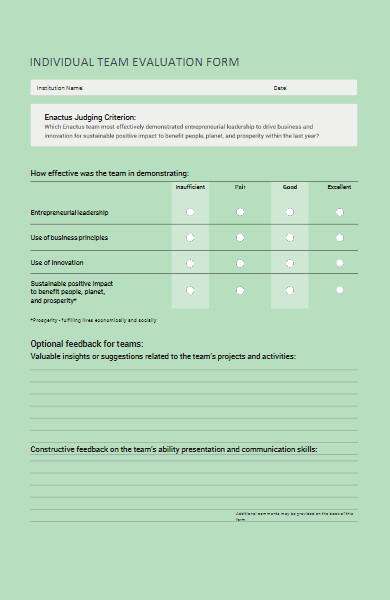
21. Individual Performance Plan Evaluation Form
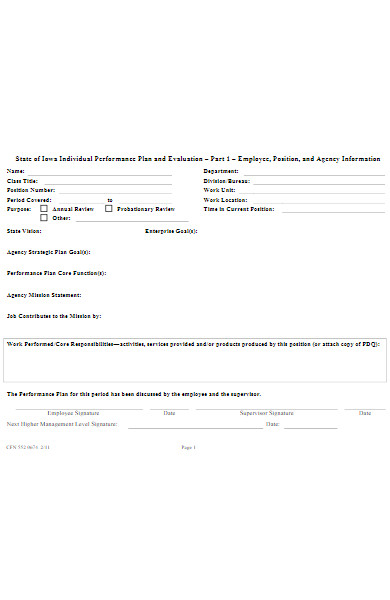
What is the primary purpose of an Individual Evaluation Form?
The primary purpose of an Individual Evaluation Form is to systematically assess and document an individual’s performance, competencies, and contributions within a specific timeframe or over a set period. These fillable form serves several key functions:
- Feedback Mechanism: It provides a structured way for supervisors, peers, or even self-assessment to offer feedback, both positive and areas needing improvement.
- Professional Development: By identifying strengths and areas for growth, the evaluation can guide training, mentoring, and other professional development opportunities.
- Decision Making: The results from the evaluation form can assist management in making informed decisions related to promotions, raises, role changes, or even terminations.
- Goal Setting: The form often includes a section for setting future objectives and goals, ensuring alignment between individual and organizational aims.
- Documentation: It serves as an official record of performance, which can be referenced in future evaluations, or if any disputes arise about performance or behavior.
- Motivation and Recognition: Recognizing accomplishments and providing constructive feedback can motivate employees, leading to increased engagement and productivity.
- Consistency: Having a standardized form ensures that evaluations are conducted uniformly across the organization, promoting fairness and objectivity.
In essence, an Individual Evaluation Form is a tool for communication, professional growth, and organizational development.
How often should the Individual Evaluation Form be filled out?
The frequency with which an Individual Evaluation Form should be filled out can vary based on organizational practices, the nature of the job, and the purpose of the evaluation. However, here are some common intervals adopted by many organizations:
- Annually: This is the most common frequency for performance reviews in many organizations. An annual review provides a comprehensive look at an employee’s performance over the entire year, allowing for reflection on accomplishments, challenges, and areas of growth.
- Semi-Annually/Bi-Annually: Some organizations prefer conducting evaluations twice a year. This can allow for more timely feedback and quicker course corrections if necessary.
- Quarterly: Quarterly evaluations can align with business quarters and allow for more regular check-ins on progress towards set objectives. They are often shorter and more focused than annual evaluations.
- Monthly: Monthly evaluations are less common and are usually more informal. They are often used for new employees during probationary periods or in roles that require rapid feedback and adjustments.
- Project-Based: In some job roles, especially project-oriented ones like those in IT or consulting, evaluations might occur at the end of major projects. This allows for feedback specific to the tasks at hand and the individual’s role within the project.
- On-the-Spot/Ad-Hoc: Some organizations encourage managers to provide feedback immediately after observing a notable positive behavior or an area of concern, rather than waiting for a formal review cycle.
- Probationary Period: It’s common for new hires to be reviewed at the end of a probationary period, which could be anywhere from 30 days to six months, depending on the organization and role.
The frequency chosen should balance the need for timely feedback and the administrative effort involved in the evaluation process. It’s essential to ensure that the frequency aligns with the organization’s goals, the nature of the jobs being evaluated, and the resources available for the evaluation process. You should also take a look at our Interview Evaluation Form.
Who will review my Individual Evaluation Form?
The reviewer of your Individual Evaluation Form can vary based on the organization’s structure, policies, and the purpose of the evaluation. Here are the common entities or individuals that might review your form:
- Direct Supervisor or Manager: This is the most common reviewer in many organizations. Your immediate supervisor, who oversees your daily work and is familiar with your tasks and performance, will often be the primary person to evaluate your performance.
- Department Head or Senior Manager: In some cases, especially in smaller departments or for critical roles, the evaluation might go up a level to department heads or senior managers.
- Human Resources (HR) Department: HR typically plays a role in the evaluation process, ensuring that the evaluations are consistent, fair, and in line with company policies. They might not review every detail of every form, but they oversee the process and handle any discrepancies or issues that arise.
- Peers or Colleagues: Some organizations utilize a 360-degree feedback system, where your peers or colleagues also provide input on your performance. This can offer a more rounded view of an individual’s contributions and behavior.
- Subordinates: If you’re in a managerial or supervisory role, those who report to you might also have a say in your performance evaluation, especially in a 360-degree feedback system.
- External Stakeholders: In some job roles, especially client-facing ones, feedback from external stakeholders like clients or partners might be considered in the evaluation.
- Self: Many evaluation processes include a self-assessment component. This allows individuals to reflect on their own performance, accomplishments, and areas of improvement. While this is not “reviewing” in the traditional sense, it’s a critical part of many evaluation processes.
- Review Committee: In some organizations, especially academic or research institutions, a committee might review evaluations, especially for promotions or tenure decisions.
When you’re provided with an Individual Evaluation Form, it’s a good practice to clarify who will be reviewing it. This helps you understand the perspective of the reviewer and can guide your responses, especially if there’s a self-assessment component. Our Internship evaluation forms is also worth a look at
Is the feedback on the Individual Evaluation Form confidential?
In most professional settings, feedback on the Individual Evaluation Form is treated with a degree of confidentiality to ensure the integrity of the evaluation process and to protect the privacy of both the evaluator and the employee being evaluated. However, the level of confidentiality can vary based on several factors:
- Organization’s Policy: Companies usually have policies in place detailing how evaluations are handled, including aspects related to confidentiality. Employees should refer to these policies or inquire with their HR department to understand the specifics.
- Nature of the Feedback: While overall evaluations might be shared with higher management or used for decision-making, specific comments or details might be kept confidential.
- 360-Degree Feedback: In cases where feedback is collected from peers, subordinates, or even external stakeholders, it’s standard practice to anonymize the feedback to ensure individuals feel comfortable sharing their honest opinions.
- HR Involvement: The Human Resources department usually plays a role in ensuring that feedback remains confidential. While HR professionals might have access to the details of the evaluation, they are typically bound by professional standards to maintain confidentiality.
- Access Rights: Even if the feedback is confidential, the evaluated employee typically has the right to see their own evaluations, especially if they need to address specific points or create a development plan.
- Legal and Regulatory Factors: In some jurisdictions, there are legal requirements related to employee evaluations, which might dictate how confidentiality is handled.
It’s essential for employees to understand their rights regarding feedback and for employers to communicate clearly about confidentiality protocols. This transparency ensures trust in the evaluation process and encourages honest and open feedback form. If there’s any doubt or concern about confidentiality, it’s always a good idea to seek clarification from the relevant organizational authority or HR department.
Will I see the results of my Individual Evaluation Form?
Yes, in most professional and organizational settings, it is standard practice for employees to be shown or discussed the results of their Individual Evaluation Form. This is because the evaluation process is not just a tool for organizational decision-making but also serves as a feedback mechanism for employees. Here’s why sharing the results is important:
- Personal Development: Seeing the results allows employees to understand their strengths and areas that need improvement, helping them make informed decisions about their personal and professional development.
- Open Dialogue: Discussing the evaluation results fosters an open dialogue between the employee and the manager or supervisor. This is an opportunity for both parties to discuss any concerns, clarifications, or further insights about the feedback.
- Goal Setting: Based on the results, employees and managers can set new goals or revise existing objectives to align with performance insights and organizational expectations.
- Transparency: Sharing the results ensures that the evaluation process is transparent, which helps build trust and credibility in the system. Employees are more likely to value and engage with a process they understand and can actively participate in.
- Addressing Discrepancies: If there are discrepancies or disagreements regarding the feedback, seeing the results allows the employee an opportunity to discuss or challenge certain points. This can lead to a more balanced and comprehensive understanding of the evaluation.
- Motivation: Positive feedback can motivate employees and reinforce desired behaviors. Even constructive criticism, when delivered properly, can motivate employees to improve.
- Future Planning: Knowing where they stand can help employees in career planning, seeking additional training, or even considering changes in role or responsibilities.
While it’s standard for employees to see their evaluation results, the format and context might vary. Some organizations might provide a written copy, while others might have a formal review meeting to discuss the results. It’s advisable for employees to ask about the process if they’re unsure, and to always request feedback if it isn’t automatically provided. In addition, you should review our Self-assessment forms.
Are there guidelines for filling out the Individual Evaluation Form?
Yes, most organizations provide guidelines or best practices for filling out the Individual Evaluation Form. These guidelines aim to ensure that the evaluation process is consistent, objective, and constructive. Here are some common guidelines and tips that are typically suggested:
- Be Objective: Focus on factual, observable behaviors rather than personal opinions or feelings. Base your assessment on evidence and specific examples.
- Avoid Biases: Try to avoid common biases like the recency bias (giving more weight to recent events) or the halo effect (letting one good trait overshadow other traits).
- Provide Specific Examples: Instead of general statements like “works well under pressure,” provide instances that demonstrate this ability, e.g., “handled the XYZ project deadline efficiently even with last-minute changes.”
- Be Constructive: When addressing areas for improvement, provide feedback that can lead to positive change rather than just criticism. Suggest possible solutions or training that might help.
- Use Clear Language: Avoid jargon or overly technical terms. Your feedback should be easy for anyone to understand.
- Cover All Areas: Ensure that you’ve addressed all sections of the form and haven’t left any crucial areas unaddressed.
- Stay Relevant: Focus on the evaluation period in question. If you’re evaluating an employee’s performance over the past year, feedback should be relevant to that timeframe.
- Self-Assessment: If the form includes a self-assessment section, be honest and balanced about your achievements and areas where you can grow.
- Seek Clarification: If you’re unsure about a section or how to address a particular point, seek guidance. This could be from a supervisor, HR representative, or any relevant authority.
- Maintain Confidentiality: If you’re involved in evaluating others, ensure that your feedback remains confidential. Avoid discussing it with those who aren’t part of the evaluation process.
- Review Before Submitting: Before submitting the form, review your responses to ensure they’re accurate, balanced, and provide a fair representation of performance.
Remember, the primary purpose of the Individual Evaluation Form is to foster growth, improve performance, and ensure alignment with organizational goals. Whether you’re evaluating someone else or assessing your own performance, the focus should always be on constructive feedback and future development.
How does the Individual Evaluation Form affect my job or promotions?
The Individual Evaluation Form plays a significant role in various aspects of your professional journey within an organization. Here’s how it can influence your job, promotions, and other career-related decisions:
- Performance Feedback: At its core, the form provides feedback on your performance. Regular feedback helps you align your efforts with organizational goals, understand your strengths, and address areas of improvement.
- Promotions: Managers and HR departments often use performance evaluations to identify potential candidates for promotions. Consistently positive evaluations demonstrate that you are meeting or exceeding expectations, making you a likely contender for advanced roles or responsibilities.
- Salary and Bonuses: Many organizations link performance evaluations with salary increments and bonuses. A favorable evaluation could result in a higher raise or bonus, while a less-than-satisfactory one might affect your monetary rewards.
- Training and Development: The evaluation form can highlight areas where you might benefit from additional training or professional development. Organizations can then allocate resources, like workshops or courses, to bridge these skill gaps.
- Goal Setting: Based on the feedback from the evaluation, you and your supervisor can set new performance goals for the next evaluation period, ensuring continued growth and alignment with departmental or organizational objectives.
- Career Pathing: The insights from regular evaluations can guide discussions about your long-term career aspirations and the path within the organization to achieve those goals.
- Job Security: On the flip side, consistent negative feedback or evaluations highlighting a mismatch between your skills and job requirements could raise concerns. In some cases, if improvements aren’t seen over time, it might affect job security.
- Team Dynamics: For roles that involve teamwork, evaluations can also touch upon interpersonal skills and collaboration. Feedback in this area can influence team compositions or suggest areas where team-building activities might be beneficial.
- Transfers or Role Changes: Sometimes, evaluations might highlight that an employee’s skills and talents might be better suited for a different department or role. This could lead to transfers or job role modifications.
- Self-awareness and Motivation: Knowing where you stand in terms of performance can boost your motivation and morale. Positive feedback can reinforce good behavior, while constructive criticism can motivate improvements.
It’s essential to approach the Individual Evaluation Form as a tool for growth rather than just a judgment mechanism. Engage in open dialogue with your supervisor or HR department regarding the feedback and its implications, and proactively seek guidance on how to leverage evaluations for your career progression. You can check our Medical Evaluation Form.
Where can I find a copy of the Individual Evaluation Form?
Obtaining a copy of the Individual Evaluation Form typically involves the following steps, depending on the context in which you’re seeking it:
- Your HR Department: If you’re employed and referring to the evaluation form used in your organization, the first point of contact should be your Human Resources (HR) department. They usually handle performance evaluations and can provide you with a blank copy of the form or guide you on how to access it.
- Company Intranet or Portal: Many companies have digitalized their HR processes. If this is the case, there might be an employee portal or intranet where you can download the form or complete it online.
- Direct Supervisor: If for some reason you’re unable to contact HR, your direct manager or supervisor might have copies of the evaluation form or can guide you on how to obtain one.
- Online Templates: If you’re not seeking a specific company’s form but just want a general Individual Evaluation Form, there are numerous websites and platforms, like Microsoft Office templates, Google Docs templates, or HR-specific websites, which offer free and downloadable performance evaluation templates.
- Professional Associations: Some professional associations related to HR and management might provide standardized or recommended evaluation forms for specific industries.
- HR Software Solutions: If your organization uses HR software solutions or performance management systems, the evaluation form might be a part of that software. Common platforms include Workday, SuccessFactors, and others.
- Purchase from Vendors: There are businesses that specialize in HR tools and resources, and they might offer more detailed or industry-specific evaluation forms for purchase.
- Custom Creation: If you’re a business owner or manager looking to introduce an evaluation system, you can also consider creating a custom Individual Evaluation Form tailored to your organization’s specific needs. Consult with HR professionals or seek external consultation for best practices.
When accessing or using an evaluation form, always ensure it captures the necessary details and aligns with the objectives you wish to achieve from the evaluation process. If using templates or forms from external sources, it’s a good idea to customize them to fit the unique requirements and culture of your organization.
How to Create an Individual Evaluation Form?
Creating an Individual Evaluation Form requires careful consideration to ensure it’s both effective and fair. Here’s a step-by-step guide to help you design one:
1. Define the Purpose:
- Understand why you’re evaluating: Is it for performance feedback, promotions, training needs, or all of the above? This will guide the content of your form.
2. Consider the Evaluation Period:
- Decide on the timeframe the evaluation should cover, e.g., quarterly, semi-annually, or annually.
3. Choose a Format:
- Decide whether the form will be digital (e.g., a fillable PDF or an online form) or printed.
- Consider using a combination of multiple-choice, scales (e.g., 1-5), and open-ended questions for comprehensive feedback.
4. Start with Basic Information:
- Include sections for the employee’s name, department, designation, evaluator’s name, and the date of evaluation.
5. Outline Key Performance Areas (KPAs):
- Identify the main areas or tasks critical to the role. For a salesperson, KPAs might include lead generation, customer retention, and sales volume.
6. Design Evaluation Criteria:
- For each KPA, define specific metrics or behaviors. For instance, for customer retention, criteria might be the number of repeat customers or feedback scores.
7. Decide on a Rating System:
- Common systems include numeric scales (1 to 5 or 1 to 10) or descriptors (e.g., Poor, Fair, Good, Excellent).
- Ensure clarity by defining what each number or descriptor means.
8. Include Open-Ended Questions:
- These allow for qualitative feedback. Examples include “What were the employee’s significant achievements this period?” or “Areas of improvement?”
9. Add a Self-Evaluation Section:
- This gives employees an opportunity to reflect on their performance, provide insights into their challenges, and highlight their accomplishments.
10. Consider Feedback from Peers or Subordinates:
- Especially useful for managerial roles, this 360-degree feedback can offer a holistic view of an individual’s performance and interpersonal skills.
11. Include a Goal Setting Section:
- Based on the evaluation, outline objectives for the next period. This can be a collaborative effort between the employee and the evaluator.
12. Provide Space for General Comments:
- Both the evaluator and the employee should have space to add any additional comments or insights not covered by the form’s specific questions.
13. Review with HR and Legal:
- Ensure that the form is compliant with any legal requirements and aligns with HR best practices.
14. Pilot the Form:
- Before a full rollout, test the form with a small group. Gather feedback and make necessary adjustments.
15. Train Evaluators:
- Ensure that those responsible for evaluations understand how to fill out the form consistently and fairly. This can involve training sessions or workshops.
16. Regularly Review and Update:
- As roles evolve and the organization grows, revisit and refine the evaluation form to ensure its continued relevance.
Finally, remember that the ultimate goal of an Individual Evaluation Form is to provide constructive feedback that fosters growth, aligns employees with organizational goals, and celebrates achievements. The form is just a tool; open dialogue and communication surrounding the evaluation process are equally crucial.
Tips for creating an Effective Individual Evaluation Form
Creating an effective Individual Evaluation Form requires clarity, objectivity, and a focus on meaningful feedback. Here are some tips to ensure your form is as impactful as possible:
- Keep it Simple: Avoid overcomplicating the form. The clearer and more concise it is, the easier it’ll be for evaluators to provide consistent feedback.
- Prioritize Relevant KPAs: Focus on Key Performance Areas (KPAs) that are most relevant to the individual’s role and the organization’s objectives.
- Use Clear Language: Avoid jargon or overly technical terms. The language should be easy to understand to ensure consistent interpretation.
- Adopt a Consistent Rating System: Whatever scale or system you choose (numeric, descriptive, etc.), use it consistently across all sections.
- Define Rating Criteria: For each scale point or descriptor, provide a clear definition. For instance, if using a 1-5 scale, explain what a “3” versus a “5” means in terms of performance.
- Encourage Constructive Feedback: Create spaces for qualitative feedback. This helps evaluators provide actionable suggestions rather than just numeric ratings.
- Add a Self-assessment Section: This allows employees to reflect on their performance, which can provide valuable context to the evaluator.
- Include a Mix of Question Types: Using a combination of multiple-choice, Likert scales, and open-ended questions can provide a well-rounded view of performance.
- Be Comprehensive but Not Excessive: While it’s essential to cover all relevant areas, avoid making the form too lengthy, which can lead to fatigue and reduced attention to detail.
- Incorporate Peer and Subordinate Feedback: Especially in team or managerial roles, consider integrating 360-degree feedback for a more holistic view.
- Test and Refine: Before implementing the form company-wide, test it on a small group and gather feedback. This will help you identify any areas of confusion or gaps in the evaluation criteria.
- Regular Updates: As job roles, company goals, or industry standards evolve, regularly update the evaluation form to ensure it remains relevant.
- Ensure Confidentiality: Emphasize the confidential nature of the feedback to ensure honest and open evaluations.
- Avoid Bias: Train evaluators to recognize and avoid common biases, such as recency bias (overemphasizing recent events) or halo effect (letting one aspect of performance overshadow all others).
- Promote Open Dialogue: An effective evaluation form is a starting point for constructive conversations. Encourage evaluators and employees to discuss results openly and collaboratively.
- Review with Stakeholders: Ensure that department heads, team leads, and HR have input in the form’s creation, as they bring varied perspectives that can enhance its effectiveness.
Remember, the evaluation form’s primary goal is to foster growth and understanding. While the form provides structure, the quality of feedback and subsequent discussions ultimately determine its effectiveness.
The Individual Evaluation Form is a crucial tool for gauging an employee’s performance, aligning with organizational goals. It encapsulates an individual’s contributions, strengths, and areas for improvement. While its format varies—encompassing different types and examples—its essence remains consistent. Crafting a precise, comprehensive form requires understanding its purpose, adopting best practices, and facilitating open communication. When effectively implemented, it becomes a catalyst for growth and development. You may also be interested in our Property Evaluation Form.
Related Posts
-
FREE 11+ Confidential Evaluation Forms in PDF | MS Word
-
FREE 4+ Applicant Appraisal Evaluation Forms in PDF | MS Word
-
FREE 23+ Employee Leave Request Forms in PDF | MS Word | XLS
-
FREE 53+ Human Resources Forms in PDF | MS Word | Excel
-
FREE 5+ Recruiter Performance Review Forms in PDF | MS Word
-
FREE 7+ Payroll Adjustment Forms in MS Word | PDF | Excel
-
FREE 3+ HR Employee Concern Forms in PDF
-
FREE 6+ Telephone Reference Check Forms in PDF | MS Word
-
FREE 3+ Consultant Bio-Data Forms in PDF | MS Word
-
FREE 7+ Compensation and Benefits Forms in PDF
-
FREE 10+ Reduced Fee Enrollment Application Forms in PDF | MS Word
-
FREE 10+ Name Address Change Forms in PDF | MS Word
-
FREE 11+ Change of Address Forms in PDF | MS Word | Excel
-
FREE 9+ Direct Deposit Revocation Forms in PDF | MS Word
-
Reclassification Request and Position Information Questionnaire [ How to Create, Questions ]
